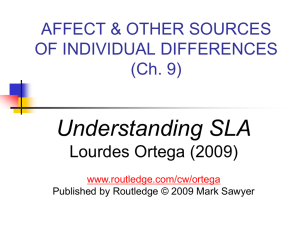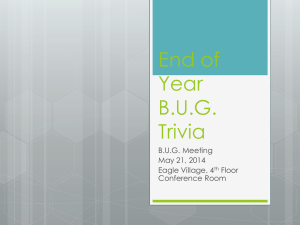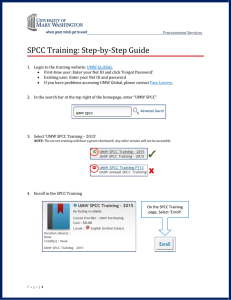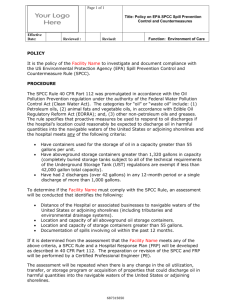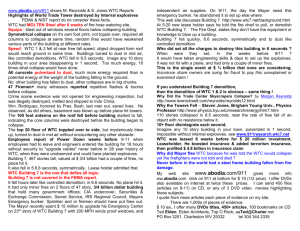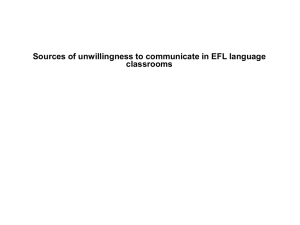Role of Self-Perceived Communication Competence and Communication Apprehension for
advertisement
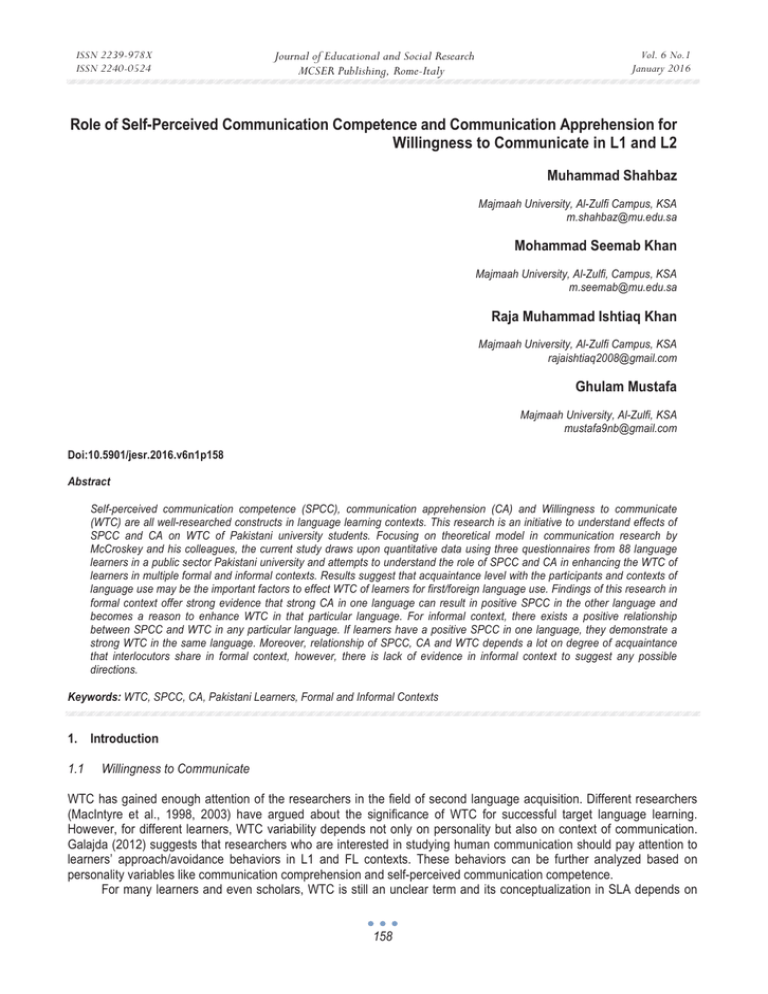
ISSN 2239-978X ISSN 2240-0524 Journal of Educational and Social Research MCSER Publishing, Rome-Italy Vol. 6 No.1 January 2016 Role of Self-Perceived Communication Competence and Communication Apprehension for Willingness to Communicate in L1 and L2 Muhammad Shahbaz Majmaah University, Al-Zulfi Campus, KSA m.shahbaz@mu.edu.sa Mohammad Seemab Khan Majmaah University, Al-Zulfi, Campus, KSA m.seemab@mu.edu.sa Raja Muhammad Ishtiaq Khan Majmaah University, Al-Zulfi Campus, KSA rajaishtiaq2008@gmail.com Ghulam Mustafa Majmaah University, Al-Zulfi, KSA mustafa9nb@gmail.com Doi:10.5901/jesr.2016.v6n1p158 Abstract Self-perceived communication competence (SPCC), communication apprehension (CA) and Willingness to communicate (WTC) are all well-researched constructs in language learning contexts. This research is an initiative to understand effects of SPCC and CA on WTC of Pakistani university students. Focusing on theoretical model in communication research by McCroskey and his colleagues, the current study draws upon quantitative data using three questionnaires from 88 language learners in a public sector Pakistani university and attempts to understand the role of SPCC and CA in enhancing the WTC of learners in multiple formal and informal contexts. Results suggest that acquaintance level with the participants and contexts of language use may be the important factors to effect WTC of learners for first/foreign language use. Findings of this research in formal context offer strong evidence that strong CA in one language can result in positive SPCC in the other language and becomes a reason to enhance WTC in that particular language. For informal context, there exists a positive relationship between SPCC and WTC in any particular language. If learners have a positive SPCC in one language, they demonstrate a strong WTC in the same language. Moreover, relationship of SPCC, CA and WTC depends a lot on degree of acquaintance that interlocutors share in formal context, however, there is lack of evidence in informal context to suggest any possible directions. Keywords: WTC, SPCC, CA, Pakistani Learners, Formal and Informal Contexts 1. Introduction 1.1 Willingness to Communicate WTC has gained enough attention of the researchers in the field of second language acquisition. Different researchers (MacIntyre et al., 1998, 2003) have argued about the significance of WTC for successful target language learning. However, for different learners, WTC variability depends not only on personality but also on context of communication. Galajda (2012) suggests that researchers who are interested in studying human communication should pay attention to learners’ approach/avoidance behaviors in L1 and FL contexts. These behaviors can be further analyzed based on personality variables like communication comprehension and self-perceived communication competence. For many learners and even scholars, WTC is still an unclear term and its conceptualization in SLA depends on 158 ISSN 2239-978X ISSN 2240-0524 Journal of Educational and Social Research MCSER Publishing, Rome-Italy Vol. 6 No.1 January 2016 some research studies in the field. WTC for L1 emerged from Burgoon (1976) who used the term “unwillingness to communicate” and associated it with concepts like introversion, self-esteem and anxiety. Mortensen et al. (1977) took this concept further in the area of human communication and argued that people have a predisposed notion of either willing or unwilling to communicate with particular person/group and in a particular situation or context. This theory of predisposition towards human behavior made them argue that people may choose to talk across various contexts and they are quite consistent about it (Mortensent et al., 1977). WTC is defined by MacDonald et. al. (2003) as a “psychological readiness to speak a second language and is based on much more than linguistic competence”. It can be considered as a possibility of engagement in communication process when learners are free to do this (McCroskey & Baer, 1985). Richmond and Roach (1992) observed that WTC contributes notably to the educational, social and organizational achievements of individual. Eagerness to communicate means general personality orientation of individual towards talking (McCroskey & Richmond, 1987). Linguistic competence as well communicative competence influences the student’s WTC.The pyramid model (situational model) by MacIntyer et al. (1998) suggests that WTC should be an integral part of language instruction and it further highlights the significant impact of WTC on learning a target language. 1.2 Self-Perceived Communication Competence According to Lockley (2013), SPCC has many potential implications for second/foreign language learning and teaching as well as it is one of the major factors in predicating WTC. McCroskey (1984:261) defines communication competence as “adequate ability to pass along or give information; the ability to make known by talking or writing”. Talking about SPCC, it can be considered as how an individual perceives her/his own competence for spoken communication in a certain context. This is an important area of research as SPCC can have a strong impact on WTC that in turn can affect FLL to a great deal. Mercer (2011) believes that accuracy of SPCC can play a vital role in FLL because accurate/inaccurate self-beliefs can provide a strong help or pose hindrance to approaches adopted for learning. SPCC is important because an awareness of personal strengths and weaknesses helps students to “adjust their own cognition and thinking to be more adaptive to diverse tasks and, thus, facilitate learning” (Pintrich, 2002). SPCC is a belief that a learner has about his/her strength to accomplish a given target in FLL and the ones who have high competency level may engage in more healthy and constructive tasks while those who have low competency may demonstrate anxiety and disappointment (Horwitz & Young, 1991). 1.3 Communication Apprehension CA is a major type of performance anxiety and researchers have devoted great time and efforts to this type of Foreign Language Anxiety (FLA). Language learning anxiety is one of the most studied areas in psychological domains of SLA. Scholars, researchers, language learners and language teachers all agree to some extent that anxiety interferes with language learning and Horwitz (2010) even goes to the extent of considering the role of anxiety as intuitive factor hindering the successful learning of a target language. Some scholars (Campbell & Ortiz, 1991) suggest that anxiety level in language classrooms is even “alarming”. It is important to note here that language learning and SLA are not only fields to talk about the significance of anxiety in the process of learning and teaching. Other scholars have used the term to explain different situations in the process of learning and constructed literature in areas like text anxiety (Sarason, 1980, 1986) and communication apprehension by Daly and McCroskey (1981). Although it is a well-researched topic, there exists a good deal of difference of opinion among scholars in the field (MacIntyer, 1999) about the definition of anxiety in language learning. Anxiety is a multifaceted concept and psychologists have offered different types of anxiety including state anxiety, facilitative-debilitative anxiety, trait anxiety and achievement anxiety. Scovel (1978: 137) notes that anxiety is “not a simple, unitary construct that can be comfortable quantified into ‘high’ or ‘low’ amounts”. However, FLA is different and scholars consider it as situationspecific anxiety. This research focuses on this kind of anxiety in classrooms and this can affect WTC in a positive or negative way. Our major focus is on CA and for the purposes of this research; we can focus on McCroskey’s definition who states that CA is more of a personal construct or reaction of the individual in a given context (2009a). 2. Literature Review There has been a good deal of research in all these areas in SLA and applied linguistics. WTC, SPCC and CA (FLA) are 159 ISSN 2239-978X ISSN 2240-0524 Journal of Educational and Social Research MCSER Publishing, Rome-Italy Vol. 6 No.1 January 2016 well-researched and established areas in international contexts. However, this study is unique in its own way as there has been no single study dealing with these three factors (WTC, SPCC, CA) in Pakistani context to the best knowledge of the researchers. Of course, there are studies dealing with individual factors but no single study to date takes into account all three factors for one research. In international context, MacIntyre (1995, 2002, 2007 and 2012) has published series of papers on issues of WTC and FLA in different contexts and settings. He and his colleagues (MacIntyre et al., 1998; MacIntyre et al., 2001; MacIntyre et al., 2003; MacIntyre & Leggato, 2010; MacIntyre, Burns & Jessome, 2011) have established these concepts and made these clear to SLA researchers and general readers. Their research has signified the importance of WTC for successful language learning and negative role that anxiety can play in second/foreign language learning. As far as CA and SPCC are concerned, in 1970’s and 80’s the focus of scholars was on “communication competence’ and different theories and measures were proposed by scholars like Self-Perceived Communication Competence Scale by McCroskey and McCroskey (1988). James McCroskey has presented results of different research works in multiple settings. He has mostly researched these from communication studies perspective. McCroskey (1970, 1972, & 2009b) has talked about communication-bound anxiety and communication apprehension in communication studies. McCroskey and his colleagues (McCroskey & McCrsokey, 1988; Sallinen-Kuparinen & McCroskey, 1991; Chesebro et al., 1992; Yung & McCroskey, 2004; and Richmond et. al., 2008) have presented results from different settings and speakers of different languages. These studies conclude that five communication traits (CA, SPCC, WTC, Shyness and Compulsive Communication) have strong relationship among them and anxiety as well as WTC greatly influences SPCC (McCroskey, 2009b). These scholars have forwarded the concept in communication studies but it remains little explored in the fields of applied linguistics and SLA in Pakistani context. In Pakistani context, previous studies have failed to consider the nature of these issue and these studies are of a very basic level (although they do hold value considering almost non-existence of research in these areas). Mari et al. (2011) use a mixed method approach to understand WTC in English as a target language. They use data from 100 questionnaires and 15 interviews to suggest that their respondents have mixed response with WTC “neither low nor high”. Students are more comfortable while talking to friends and in familiar situations. Anxiety and hesitant attitude figure out as major factors for qualitative part. In another recent study, Arshad, Shahbaz and Bashabsheh (2015) explore the WTC of 353 university students based on gender and their results show that both genders demonstrate arguable differences in various settings, however, their overall WTC within and out of classroom remain the same. The study further highlights that boys are more willing to speak compared to girls. Girls, on the other hand, demonstrate high preferences for in reading and writing. Recently, Hussain and Shahbaz (under-review) collected data from 331 students and explored their WTC in various settings where results reveal that students lack the aspect of WTC in English and they do so only because teachers require them to do so. These three studies present one common result of low level WTC among learners of English in Pakistan but none of these focuses on the factors that affect WTC in this context. SPCC is a neglected area in Pakistani ESL/EFL contexts and we could only find a single study dealing with SPCC. In this sole attempt, Sultan (2012) has measure the effects of SPCC on FLA of students at a university in Pakistan. With a sample of 157 participants, her results suggest that students with low SPCC depict higher levels of anxiety and boys have a higher SPCC level compared to girls in the same setting. Unfortunately, no other research work deals with SPCC in Pakistani context. FLA and CA receive more attention compared to other constructs in this study. Different scholars have explored FLA but CA remains an under-explored area. Using Personal Report of Communication Apprehension (PRCA) by McCroskey (1970), Akram (2009) collected data from 35 participants. The results exhibit a strong correlation between CA and achievement. Participants lack confidence, feel embarrassed and clumsy. In addition, the author highlights that teacher-oriented classrooms pose great threats to learners’ productivity. While focusing on oral skills of the engineers, Kakepoto et al., (2013) conclude that CA affected the confidence and presentation skills of the participants. According to authors, lack of confidence and nervousness can cause serious damage to workplace environments. Mushtaq (2014) presents data from 100 students but most of his conclusion remain philosophical and lack evidence in the paper itself. The author suggests that the linguistic and paralinguistic expressions can help to overcome CA. 3. Research Questions Previous research (MacIntyre et al., 2003; Galadja, 2012) suggests that SPCC and CA have a role to influence WTC. In light of the relevant literature we have discussed in preceding paragraphs, it is apparent that there is a dearth of research on this topic in Pakistani context. Pakistanis are learning foreign languages and there are so many language institutes 160 Journal of Educational and Social Research MCSER Publishing, Rome-Italy ISSN 2239-978X ISSN 2240-0524 Vol. 6 No.1 January 2016 and universities, yet, we know very little about these construct in our setting. Therefore, this study will try to dig these concepts a bit further to fill the existing gap in the literature. Results of this study can be beneficial for look as well as international audience but more importantly; this research can bring this topic into limelight and encourage other researchers to explore these topics from multiple perspectives in Pakistani context and elsewhere in world. Specifically, this study is an exploration to answer following questions: 1- To what extent do SPCC and CA influence WTC of university students in L1 and FL? 2- Are there any differences in effects of SPCC and CA on WTC in L1 and L2? 4. Methodology and Data Collection Selection of a suitable research method can be a challenging task; however, many novice researchers usually prefer survey methods, as they are comparatively easy to deal with in the process of research. As we have mentioned earlier that this study is fairly unique in Pakistani context and there is a dearth of sufficient literature about the use of methodology in Pakistani context, we also used simple questionnaires to explore these constructs. We believe that qualitative or mixed method approach can offer further insights; however, time factor and absence of any funding made it difficult for us to experiment with other designs. All the three variables in this study have received good attention of the researchers and they have carefully explored these as independent variables. However, we need further research to understand the association between SPCC and CA and how these two constructs affect WTC for language learning. We used three established questionnaires to collect data from the field of SLA and educational psychology. These three scales are: a) SPCC scale (McCroskey & McCroskey, 1988); b) PRCA Scale (McCroskey & Richmond, 1982) and c) WTC Scale (McCroskey, 1992). Population of this study is university students learning English in Pakistan, especially learners of English in 2nd year of their BS programs. Participants of this study are 2nd year students of BS English program from University of Gujrat, Pakistan. We selected the 2nd year students because they have stayed one year at university and they are well familiar with the environment over there. They are supposed to be more confident and good at English compared to 1st year students who join university after completing their senior high school. At the time of this research, these students were enrolled in BS English program in two different sections (they had the same teachers for all courses in 1st years). The data collection took place at the time of their regular classes but two groups sat in one room. There were 104 students in two sections but on the day of data collection, 92 students appeared in the hall. We have to discard four questionnaires because there was not enough information provided by participants. Table 1 exhibits the information about the participants of this research. Table 1: Biographical Information of the Participants Total 88 Girls 47 Age Gender Boys 38 Missing 03 Mean 19.1 SD 1.13 In the beginning, class teachers (researchers themselves) introduced the three terms to students in easy language and, then, they asked questions to make things clear. It was important because all these terms are quite new in Pakistani context and familiarization was important for clear answers. We made it clear that it is not a test or exam and only true answers will serve our purpose. We assured students that there identity will not be disclosed under any circumstances and we will use collected data for research purposes only. It took almost 40 minutes for all participants to complete three questionnaires. 5. Data Analysis and Discussion Descriptive analyses of the data offer a picture of how learners feel and react in response to one construct in the study. Given the fact that this study is of pioneering nature in the concerned areas of SPCC, CA and WTC in Pakistani setting, it serves the basic purpose of understanding this phenomena in ESL/EFL classrooms and how future research can take some suggested directions to find better solutions for successful language learning. Both first language (Urdu) and foreign language (English) contexts become focus of attention. Questionnaire statements were categorized into two 161 ISSN 2239-978X ISSN 2240-0524 Journal of Educational and Social Research MCSER Publishing, Rome-Italy Vol. 6 No.1 January 2016 groups based on context, i.e. formal or informal. For each statement, assessment could be made on 0% to 100% scale that demonstrates the willingness, competency and anxiousness of the participants. Questionnaires asked students about the WTC, SPCC and CA in situations like one to one communication with a lecturer, speaking in a group or in front of public, talking to a university friend and communicating with a university acquaintance. 5.1 Communication with a Lecturer The results of this study illustrate that learners have strong WTC (50%) while communicating with a teacher in L1. During private conversations with a lecturer, these participants feel relaxed and more competent (80%) to talk in L1. This is very much in line with existing beliefs in the field. In countries like Pakistan, teachers still enjoy good authority and talking to a university professor in a foreign language can be a demanding task. Students feel relaxed and comfortable to use L1 instead of a FL. They are even more inclined to use L1 with a teacher to express their personal problems or matters because L1 offers the opportunity to sound clear and simple. Use of FL to explain a problem or difficult can really add burden for the learners. In situations that involve more formal academic contexts (oral exam), these students tend to use FL (50%). For CA, students are afraid to talk with a teacher in FL (80%). All the participants are from BS English class and all their exams are conducted in English. In Pakistani contexts, most of the exams if not all (academic or jobs), are demand usage of English to some extent. Therefore, they feel more motivated to communicate with a teacher in FL. Sometimes there are some linguistic or non-linguistics terms that are difficult to translate or explain in local language (Urdu language has absorbed many English words like loudspeaker which are almost impossible to explain), so, students feel comfortable to use FL. Another motivation to speak FL for oral exam might be the factor of grades. They are afraid to use FL but instrumental motivation encourages them to use English in this context. The above results explain that a positive SPCC can predict a higher level of WTC in communication between a student and a teacher at university level in Pakistan. However, we can see that even with a strong SPCC for L1, students tend to use FL for oral exams. In comparison, CA or anxiety can have strong impact on WTC and if students have a strong sense of CA to communicate in FL, then, there are great numbers of chances that those learners will use L1 for communication. The results suggest that it is hard to negate the role of SPCC and CA for WTC in formal contexts like talking with a lecturer, however, CA can be better predicting factor for WTC of the learners in a language. This discussion further highlights that communication with a lecturer a major problem for many learners in teacher-oriented contexts like Pakistan. Superior position of the teacher and her/his authoritative behavior (as well as cultural norms to respect and obey teachers in all situations) threaten students and provides grounds for higher level of CA. 5.2 Speaking in Public Answers of the participants in this context suggest that students show willingness to choose FL (40%) when speaking in large public groups (30 or more) and prefer L1 (40%) to talk when speaking to a smaller public group (10 or less). Although data suggests that students feel competent enough to choose L1 and FL in both contexts, the participants still exhibit high levels of anxiety (70%) in FL usage. Usually, public speaking offers threats for language users because different reasons like face-saving and nervousness. At times, people lack confidence, observe a sense of incompetency and they feel anxious. Looked at from this perspective, we can assume that SPCC and CA directly contribute to learners’ WTC. Sense of incompetency and feelings of anxiety can both pose serious threats to one’s WTC and the relationship among these variables becomes more than simple. Participants’ responses show that they are more comfortable to use FL when other communication partners form a large group, which makes it easy to assume that in a bigger group, the speakers feel anonymous. This sense of anonymity decreases the feelings of anxiety and fear. Speaker takes the risk of talking to a big group and even making mistakes because he/she thinks that not many people among the group know him/her. In contrast to this, in smaller groups, people have to interact more often and group members often know each other well. In these contexts, L1 becomes the best choice since all interlocutors can equally take part in the discussion with similar proficiency of the native language. This selection of L1 enables them to illustrate a strong sense of WTC and feelings of anxiety can diminish or even vanish for the time being. The results of the study emphasize the fact that SPCC can be deceptive at occasions because it is difficult for learners to explain their true competency level. Usually, learners weigh themselves higher and better than what they actually are. However, results guide us to assert that CA can play a vital role in forecasting WTC (L1 & FL) of university students. Even with higher levels of SPCC, students still feel afraid to use language in front of a public group. 162 ISSN 2239-978X ISSN 2240-0524 5.3 Journal of Educational and Social Research MCSER Publishing, Rome-Italy Vol. 6 No.1 January 2016 Communication with a University Friend Results explain that students share a strong sense of WTC (100%) in L1 for private communications with a friend. Participants also feel highly willing (90%) to use L1 while asking a favor from their friends. Results further show that students are more comfortable to communicate in FL (90%) while working on a task with a university friend. Participants feel that they are communicatively competent (100%) to use L1 for private conversations with university friends. However, they tend to consider themselves competent to use FL (90%) while working on academic tasks and competent in FL (90%) when asking a friend for a favor. Students also demonstrate a sense of anxiety (30%) while communicating with a university friend in a target language. These results explain WTC, SPCC and CA of language users for use of L1 or FL in these contexts. People tend to look for easy and natural phenomena and even they are competent enough to speak in a foreign or second language, they prefer to talk about their private and personal matters in L1. Academic tasks are usually perceived as a learning activity and there are different concepts and terms, which are more realistic in target language compared to L1. Therefore, it is natural that participants tend to choose FL for tasks and L1 for private conversations with their friends. An analysis of these results shows that a positive sense of SPCC may result in higher levels of WTC in the similar contexts. The more competent students feel about performing tasks in any particular language, more the chances that they are willing to use that particular language for communication in various situations. Students demonstrate a strong sense of WTC for asking a favor from a friend but, at the same time, participants show a positive SPCC to use FL for asking favors. We can assume that L1 can be associated with personal matters like asking for a favor from a close university friend and WTC for L1 is but a natural choice. In comparison, use of FL offers the opportunity to create an artificial distance in communication while asking a favor from somebody, even close friends. FL languages usually have less strong impact on the audience (at least this is so in Pakistan) and it helps the speaker to save-face while asking for a favor from a close friend as it serves to make it less personal and more anonymous. Overall, participants of this study feel strongly motivated to communicate with university friends in all situations and they feel themselves positively competent to do so. However, for FL, higher levels of CA in the communication with university friends may negatively affect the WTC of learners to use FL with friends in all situations. 5.4 Communicating with a University Associate Results suggest that, on one hand, participants of the study feel anxious (50%) and competent (90%) to use L1 while requesting a favor or talking privately to a university associate or acquaintance. On the other hand, they are in favor of using FL (60%) to talk while working on a task with the same person even though CA (40%) exists for such communications. In a communication with an associate from the university, participants demonstrate more WTC in L1 than FL. In Pakistani universities, hundreds of students study in the same department and there are still more from other departments to visit. Learners meet acquaintances in lectures and while roaming about in the university, however, these occasional meetings do not work to develop a strong relationship among them. There remains a sense of strangeness and FL is usually a better choice in such situations. However, L1 offers great opportunities for clarity and face-saving in front of others, most people choose L1 to communicate with peers in the university. L1offers the ease of clarity and encourages them to communicate with those they do not know well. An important point to note here is that even if students have a strong sense of competency in a FL, still, they demonstrate higher levels of CA for communicating in the same level. This suggests that a positive SPCC does not always guarantee the absence of CA in the communication process. We can find this kind of complicated relationship in FL communications where students often feel competent to use a language for different kinds of tasks (like academic tasks and presentations) but they demonstrate FL anxiety. Therefore, feelings of SPCC and CA do not always lead to positive WTC for learners. 5.5 Talking to a Stranger For a private conversation with a stranger or asking her/him some favor, participants of the study demonstrate SPCC (70%) and WTC (40%) to use L1. They also feel that they have SPCC (90%) for FL and SPCC (80%) for L1 while speaking to a stranger when working with him on a project or assigned task. Participants demonstrate CA (100%) in FL when speaking with strangers and CA (70%) when talking to strangers in all contexts of the study. 163 ISSN 2239-978X ISSN 2240-0524 Journal of Educational and Social Research MCSER Publishing, Rome-Italy Vol. 6 No.1 January 2016 Pakistan is going through socio-political turmoil where people do not believe many. In such a scenario, it is very much natural and understandable that students feel anxious to communicate with strangers in the university. Within a university, there are usually thousands of students and most them remain strangers for other learners or students. Learners meet these students (strangers) during seminars or other gatherings where they have to communicate and cooperate to complete any task or duty. These are usually tense and strange situations and this becomes reason why most learners tend to avoid communication with strangers. Participants of the study show willingness for L1 for speaking with strangers in different contexts and situations. Learners tend to choose L1 because they are confident about their abilities to use it most situations and make their point clear. Another notable point is that learners show higher levels of WTC for people they know better in comparison to those they are not quite familiar. The positive the level of SPCC, higher the WTC in that language and more familiar the interlocutors are, higher WTC with those interlocutors. We can also say that learners feel afraid to make mistakes in front of others in a FL and therefore, they tend to choose L1 for communication with strangers or less familiar people. Overall, it can be suggested that in most situations, positive SPCC results in strong WTC in any particular language or context. 5.6 Analysis for L1 and FL Contexts The discussion in preceding sections provides strong evidence that SPCC has a strong role in enhancing WTC in L1 for university learners in Pakistani context. However, there is not enough evidence to believe that learners have positive SPCC beliefs in L1 and these positive beliefs help them to communicate more with unknown or strangers in the university. Students have CA while talking to strangers in all situations. The evidence from the results also makes it clear that there is no direct relationship between CA and WTC and this is true for formal as well as informal situations. In comparison to CA, SPCC has different impact on WTC of the learners in L1. The learners demonstrate a strong sense of positive SPCC to communicate in formal contexts using their mother tongue and they also become more motivated to communicate with others in formal contexts like speaking with a university teacher or speaking to a group of people. These outcomes of current study help to endorse a strong relationship between SPCC and WTC for L1 in most contexts. All contexts of research for this study point out a noticeable contribution of positive SPCC beliefs in L1 to WTC of learners to talk in L1. Therefore, we can confidently assume that SPCC has a strong role to play while enhancing WTC in L1 and CA has little or no real role to influence WTC in L1 situations. Results vary to some extent for researched FL contexts. Unlike L1, there are contexts where CA and SPCC appear to have an influence on WTC of the learners in FL. SPCC and CA add significantly to WTC of learners while working on a task. The participants demonstrate a higher level of CA while communicating with a university friend or a university acquaintance; however, these learners still show a positive SPCC and strong WTC for using FL while doing some work on any task with the same people. Moreover, this is the only contexts from researched situations where they are willing to use FL despite a strong feeling of CA. In addition to these findings, data suggest that there is no significant relationship among WTC, SPCC and CA in FL contexts. On one hand, being anxious to use FL does not always result in low SPCC and little WTC in FL situations. There is no direct association between positive/negative SPCC on low/high CA and weak/strong WTC in the researched FL contexts. In fact, this is first research of its type in Pakistani context (to our best knowledge) and other researchers need to explore both L1 and FL situations from different perspectives to generalize the results of this study. 6. Conclusion Based on findings of this study, we can draw a general conclusion that WTC of Pakistani students in university context has a strong impact on studied variables of the study (SPCC & CA). Results point out that WTC is no simple construct and researchers need to carefully choose different variables to develop an understanding of this issue in university contexts. WTC like L2 motivation appears to be complex phenomena and new/unique methods need to be devised to understand its existing situation for university students. There are many factors that influence WTC (not only SPCC & CA), and any framework/model that wishes to encompass WTC in its totality should consider recent changes in fields of first/second language acquisition and applied linguistics (maybe a better choice is complex dynamic systems theory by Larsen-Freeman, 2012). Other researchers should study the contribution of SPCC and CA on WTC for other first and foreign languages (Urdu & English for this study). It is difficult to generalize these research findings to other situations because there exists a relationship between L1 and FL. If L1 of the learners’ changes, it is believed that role of SPCC and CA will also change in affecting WTC of the learners. A fuller understanding of SPCC, CA and WTC is possible if we 164 ISSN 2239-978X ISSN 2240-0524 Journal of Educational and Social Research MCSER Publishing, Rome-Italy Vol. 6 No.1 January 2016 study the constructs from different perspectives, for multiple languages and for various contexts (not only university context). Acquaintance level with the participants and contexts of language use may also be the important factors to effect WTC of learners for first/foreign language use. Findings of this research in formal context offer strong evidence that strong CA in one language can result in positive SPCC in the other language and becomes a reason to enhance WTC in that particular language. For informal context, there exists a positive relationship between SPCC and WTC in any particular language. If learners have a positive SPCC in one language, they demonstrate a strong WTC in the same language. Moreover, relationship of SPCC, CA and WTC depends a lot on degree of acquaintance that interlocutors share in formal context, however, there is lack of evidence in informal context to suggest any possible directions. To sum up, we have explored the relationship of SPCC, CA and WTC in a Pakistani university context. In addition, we have also tried to understand the influence of SPCC and CA on WTC for learners of English in Pakistan. Results have presented a blur picture, which should be acceptable given the fact that this is first study of this nature in Pakistani context. We can safely assume that there is a strong relationship among the studied variables; however, there is a need to explore these factors in other contexts and perhaps with different theoretical models. We suggest that future research should explore these variables using qualitative or mixed methods approach to develop a better understanding of WTC construct in Pakistan and elsewhere in world. Longitudinal and cross-sectional studies can also help to appreciate the importance of WTC and role it can play in motivating learners to communicate in most situations for successful first/second/foreign language learning. References Akram, M. (2009). Communication Apprehensions in English Language Classrooms in Schools in Pakistan. Language in India, 9:7, 2534. Arshad, Z., Shahbaz, M., & Bashabsheh, A. M. B. (2015). Willingness to Communicate in English: A gender-based study. International Journal of English and Education, 4:4, 311-19. Burgoon, J. K. (1976). The unwillingness-to-communicate scale: Development and validation. Communication Monographs 43:1, 60-69. Campbell, C. & Ortiz, J. (1991). Helping students overcome foreign language anxiety: a foreign language anxiety workshop. In E. K. Horwitz & D. J. Young, (Eds.). Language Anxiety: From Theory and Research to Classroom Implications. Englewood Cliffs, NJ: Prentice Hall, 153-168. Chesebro, J. W., McCroskey, J. C., Atwater, D.F., Bahrenfuss, R. M., Cawelti, G., Gaudino, J. L., & Hodges, H. (1992). Communication apprehension and self-perceived communication competence of at-risk students. Communication Education, 41(4), 345-360. Daly, J. A., & McCroskey, J. C. (1984). Avoiding communication: Shyness, reticence, and communication apprehension. Beverly Hills, CA: Sage. Galadja, D. (2012). Perceived Competence and Communication Apprehension-the Affective Variables of Willingness to Communicate in L1 and FL. Paper presented at International Conference “ICT for Language Learning” 5th edition, 15-16 November, Florence, Itlay. Hussain, K., & Shahbaz, M. (under-review). Motivational Orientation and Willingness to Communicate among Pakistani ESL Learners. Horwitz, E. K. (2010). Foreign and second language anxiety. Language Teaching 43:2, 154-167. Horwitz, E. K., & Young, D. J. (1991). Language anxiety: From theory and research to classroom implications. Upper Saddle River, NJ: Prentice Hall. Kakepoto, I., Said, H., Habil, H., Umrani, A. I., & Memon, I. A. (2013). Analyzing Oral Communication Apprehension prevailing among Engineer in Engineering Workplace of Pakistan. Journal of Economics and Sustainable Development, 4:3, 255-261. Larsen-Freeman, D. (2012). Complex, dynamic systems: A new transdisciplinary theme for applied linguistics? Language Teaching, 45:2, 202-214. Lockley, T. (2013). Exploring self-perceived communication competence in foreign language learning. Studies in Second Language Learning and Teaching 3:2, 187-212. MacDonald, J., Clément, R., & MacIntyre, P. (2003). Willingness to communicate in a L2 in a bilingual context: A qualitative investigation of Anglophone and Francophone students. Unpublished manuscript, Cape Breton University, Sydney, Nova Scotia, Canada. MacIntyre, P. D. (1995). On seeing the forest and the trees: A rejoinder to Sparks and Ganschow. Modern Language Journal, 79,245248. MacIntyre, P. D. (1999). Language anxiety: A review of the research for language teachers. In D. J. Young (Ed.), Affect in foreign language and second language learning: A practical guide to creating a low-anxiety classroom atmosphere (pp. 24–45). Boston: McGraw-Hill. MacIntyre, P. D. (2002). Motivation, anxiety and emotion in second language acquisition. In P. Robinson (Ed.) Individual Differences and Instructed Language Learning. John Benjamins, pp. 45-68. MacIntyre, P. D. (2007). Willingness to communicate in the second language: Understanding the decision to speak as a volitional process. Modern Language Journal, 91, 564-576. 165 ISSN 2239-978X ISSN 2240-0524 Journal of Educational and Social Research MCSER Publishing, Rome-Italy Vol. 6 No.1 January 2016 MacIntyre, P. D. (2012). Currents and Waves: Examining willingness to communicate on multiple timescales. English Language Teaching Magazine, 34:2, 12-22. MacIntyre, P. D., Clément, R., Dornyei, Z., & Noels, K.A. (1998). Conceptualising willingness to communicate in a L2: A situational model of L2 confidence and affiliation. Modern Language Journal, 82, 545–562. MacIntyre, P. D., Baker, S., Clément, R. & Conrod, S. (2001). Willingness to Communicate, Social Support and Language Learning Orientations of Immersion Students. Studies in Second Language Acquisition, 23,369-388. MacIntyre, P.D., Baker, S.C., Cleғment, R., & Donovan, L.A. (2003). Talking in order to learn: Willingness to communicate and intensive language programs. The Canadian Modern Language Review, 59, 587-605. MacIntyre, P. D. & Legatto, J. J. (2010). A dynamic system approach to willingness to communicate: Developing an idiodynamic method to capture rapidly changing affect. Applied Linguistics, 32 (2), 149-171. MacIntyre, P. D., Burns, C., Jessome, A. (2011). Ambivalence about communicating in a second language: A qualitative study of French immersion students’ willingness to communicate. Modern Language Journal, 95, 81-96. Mari, M. A., Pathan, H., & Shahriar, A. (2011). Willingness to Communicate in L2: A perception of Pakistani university students. EFL Annual Research Journal SALU 13, 65-82. McCroskey, J. C. (1970). Measures of communication-bound anxiety. Speech Monographs, 37(4), 269-277. McCroskey, J. C. (1972). The implementation of a large-scale program of systematic desensitization for communication apprehension. The Speech Teacher, 21, 255-264. McCroskey, J. C. (1984). Communication competence. The elusive construct. In R. N. Bostrom (Ed.) Competence in communication: A multidisciplinary approach, (pp. 259-268). Beverly Hills, CA: SAGE Publications. McCroskey, J. C. (1992). Reliability and validity of the willingness to communicate scale. Communication Quarterly, 40, 16-25. McCroskey, J. C. (2009a). Communication Apprehension: What We Have Learned in the Last Four Decades. Human Communication 12(2), 179-187. McCroskey, J. C. (2009b). Communication Apprehension: What have we learned in last four decades. Human Communication. A publication of the Pacific and Asian Communication Association, 12:2, 157-171. McCroskey, J. C., & Richmond, V. P. (1982). Communication apprehension and shyness: Conceptual and operational distinctions. The Central States Speech Journal, 33, 458-468. McCroskey, J. C, & Baer, J. E.(1985). Willingnessto communicate: The construct and its measurement. Paper presented at the Speech Communication Association convention, Denver, CO. McCroskey, J. C., & Richmond, V. P. (1987). Willingness to communicate. In J. C. McCroskey, & J. A. Daly (Eds.), Personality and interpersonal communication (pp. 129-156). Newbury Park, CA: SAGE Publications. McCroskey, J. C., & McCroskey, L. L. (1988). Self-report as an approach to measuring communication competence. Communication Research Reports, 5(2), 108-113. Mercer, S. (2011). Towards an understanding of language learner self-concept. Dordrecht: Springer. Mortensent, D.C., Arnston, P.H. & Lustig, M. (1977). The measurement of verbal predispositions: Scale development and application. Human Communication Report 3:2, 146-158. Mushtaq, M. (2014). Factor Affecting Communication of Pakistani Students. International Journal of English and Education, 3:1, 278286. Pintrich, P. R. (2002). The role of metacognitive knowledge in learning, teaching, and assessing. Theory into Practice 41(4): 219–225. Richmond, V. P. & Roach, K. D. (1992). Power in the classroom: Seminal studies. V. P. Richmond and J.C. McCroskey (eds.) In Power in the classroom: Communication, control, an concern. Hillsdale, NJ: Erlbaum, 47-66. Richmond, V., McCroskey, J. C., McCroskey, L. & Fayer, J. (2008). Communication Traits in First and Second Languages: Puerto Rico. Journal of Intercultural Communication Research 37 (2), 65-73. Sallinen-Kuparinen, A., McCroskey, J. C., & Richmond, V. P. (1991). Willingness to communicate, communication apprehension, introversion, and self-reported communication competence: Finnish and American comparisons. Communication Research Reports, 8, 55-64. Sarason, I. G. (1986). Test anxiety, worry, and cognitive interference. In R. Schwarzer (Ed.), Self-related cognitions in anxiety and motivation (pp. 19–34). Hillsdale, NJ: LEA. Sarason, I. G. (Ed.) (1980). Test anxiety: Theory, research, and applications. Hillsdale, New Jersey: Lawrence Erlbaum Associates. Scovel, T. (1978). The effect of Affect on foreign language learning: A review of the anxiety research. Language Learning 28.1, 129– 142. Sultan, S. (2012). Students’ Perceived Competence Affecting Level of Anxiety in Learning English as a Foreign Language. Pakistan Journal of Psychological Research, 27:2, 225-239. Yung, H. Y., & McCroskey, J. C. (2004). Communication apprehension in a first language and self-perceived competence as predictors of communication apprehension in a second language: A study of speakers of English as a second language. Communication Quarterly, 52, 170-181. 166

